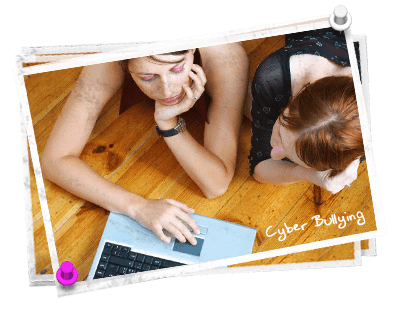Cyberbullying is the term for any kind of harassment, embarrassment, or bullying using the Internet, cell phones, or other interactive technology. A teenager involved in cyberbullying can receive a misdemeanor cyberharassment charge or a juvenile delinquency charge. However, if hacking or identity theft is involved, it is a serious federal crime.
What is cyberbullying?
- It can either be done directly, or indirectly (the bully hacks your account and posts negative things that cause your friends to turn against you, for example. The friends are bullying on behalf of the bully)
Examples of cyberbullying
- Instant Messaging or Text messaging Harassment: sending mean messages to others, posing as the victim online, sending inappropriate photos, sending death threats
- Stealing passwords: posing as the victim, editing the victim’s online profile to include hateful information to offend others so they will not be friends with the victim, locking the victim out of his/her account
- Web sites: creating Web sites or blogs that insult others, posting other peoples’ personal pictures or information
- Pictures sent through E-mail and Cell phones: sending naked pictures of other teens via E-mail or Cell phones, posting these photos online, uploading them on programs where people can download them, taking pictures of teens sneakily and sending them
Cyberbullying has negative effects:
- Sadness and depression
- Suicidal thoughts and suicide
- Low self-esteem
- Violence
- Problems in school
Is cyberbullying different from traditional bullying? Yes.
- Cyberbullying can be more dangerous than traditional bullying
- The bully can hide behind a disguise so often, the victim does not even know who the bully is
- The victim does not always know why he or she is being targeted
- Cyberbullying can go viral – meaning that the attacks may be shared on the Internet for all to see, and people can easily show others
- Cyberbullies are crueler because they are not attacking their victim face-to-face.
- Finally, cyberbullying is often more dangerous than traditional bullying because parents, teachers, and other trusted adults do not always have the technological knowledge to keep up with teens’ activity online
What can I do about cyberbullying?
- Speak with a trusted adult about online experiences that make you feel uncomfortable
- Save or print all cyberbullying evidence to show a trusted adult
- Ignore minor bullying – if you respond it will just egg them on
- Look into the privacy controls on the Web sites or messaging programs you use – you can control who sees your profile, who can contact you, and more.
- If you are not involved in cyberbullying but you witness it happen – do something. Tell a trusted adult about what you saw and who was involved. And do not encourage the behavior by laughing at it or sending it to your friends.
(reference: Cyberbullying Research Center)
